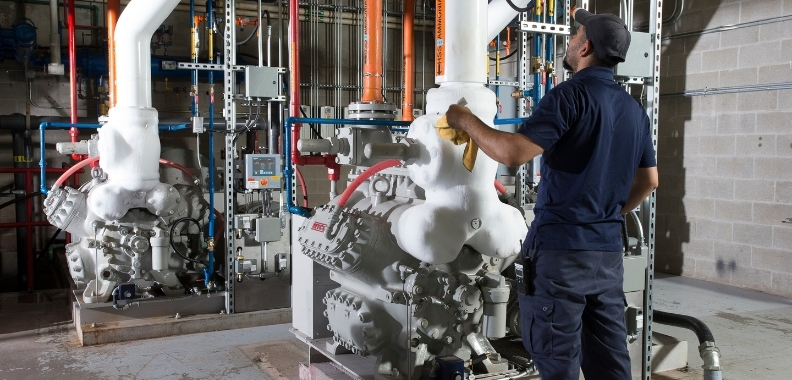When working in the industrial ammonia refrigeration field, it’s vital employees know potential safety hazards and proper safety procedures in the event an accident occurs. Ammonia is the lifeblood of many chilling systems but it can also be lethal. Understanding how it works, and how to use it safely is critical. Everyone, even experts from ammonia refrigeration companies should be cautious when working with ammonia.
A tragic example of this took place in British Columbia in 2017, when a pinhole in an ice rink brine chiller allowed Ammonia and brine to mix. This resulted in Ammonia levels immediately dangerous to life, and a refrigeration system mechanic and two municipal employees were killed.
Refrigeration-grade Ammonia, Anhydrous Ammonia, is composed of nitrogen and hydrogen and can be either a liquid or a gas. The Department of Transportation classifies it as a non-flammable compressed gas. It is extremely hard to ignite and is therefore very stable.
However, because it is so toxic to humans, the maximum allowable exposure level of Ammonia for an eight-hour work day is 50 parts per million (ppm). At those levels, it’s scent is detectable by most people and should be taken as a warning sign. Your business’s WHMIS information should include information on Ammonia and industrial ammonia refrigeration systems.

Ammonia dissolves readily in water, forms a strong alkaline solution and gives off heat. When it is mixed with even a trace amount of water, it will attack copper, zinc, tin, cadmium and most of their alloys. It can also dissolve many rubbers and plastics.
Although Ammonia is stable on its own, it can form unstable compounds and even explosives, especially as it reacts with mercury, halogens, hypochlorites and nitrogen oxides. When mixed with some organics, it can cause chemical and frost burns. It boils at an atmospheric pressure of -33o Celsius.
Liquid Ammonia expands quickly with heat – and because of this, liquid Ammonia should not be trapped in pipelines or fittings between shut-off devices. A rise in room temperature may provide enough heat to expand the liquid, which will generate enough pressure to rupture refrigeration system components.
Adequate ventilation around an ammonia refrigeration unit is the best defence. In areas where there is machinery with components that contain Ammonia, always ensure there is adequate ventilation. As Ammonia gas is lighter than air, it will rise and can easily and effectively be dispersed from the area via an effective ventilation system.

A refrigeration system contains Ammonia in both liquid and gas forms. Industrial Ammonia Refrigeration systems have components such as compressors, piping and vessels which are designed to contain ammonia at the correct pressure. Should parts of the system such as pipes, joints or valves need to be removed, a properly qualified person will need to ensure the relevant parts of the cooling systems have been depressurized and purged of Ammonia.
Excessive vibrations due to poorly aligned, out of balance or overly warm machinery can cause premature failure of piping and other refrigeration system components. Similarly, sources of heat and flame, including welding activity, should be kept well away from a refrigeration system. There is a risk of liquid Ammonia expanding and rupturing components of the system and escaping into the air.
Corrosion on external surfaces of steel piping and vessels used for refrigeration systems can reduce the effectiveness of containment – and eventually leaks may occur. As previously discussed, the Fernie Memorial Arena accident was caused by a pinhole leak which developed due to corrosion. Care must be taken to reduce corrosion, especially in wet and damp conditions and when metal temperatures are below the dew point.
Insulation does make a difference; however, if insulation is defective or incomplete, condensation will not be prevented and corrosion will not only occur but possibly be hastened. Corrosion occurs slowly on lines permanently below 0o Celsius, but in situations where hot gas defrosts lines and in conditions where dampness and heat are together, corrosion can happen very quickly. Additionally, in systems designed to be oil-free, internal corrosion may occur.
Corrosion can also be enhanced in industrial ammonia refrigeration systems that have heat-transferring liquids such as calcium chloride or sodium chloride. Chemical treatments for this are available and the advice of suppliers should be rigorously respected.
With its combination of gases, solutions, piping and compressors, an industrial refrigeration system is complex. To allow it to work effectively and safely, companies like Berg Industrial Service can provide you with advice, installation, service and parts.
Ammonia refrigeration companies like Berg Industrial Service provide installation, service and parts for various cooling applications and systems. With over 150 years of experience in a range of disciplines, we have the history and certifications to properly manage your ammonia refrigeration needs.